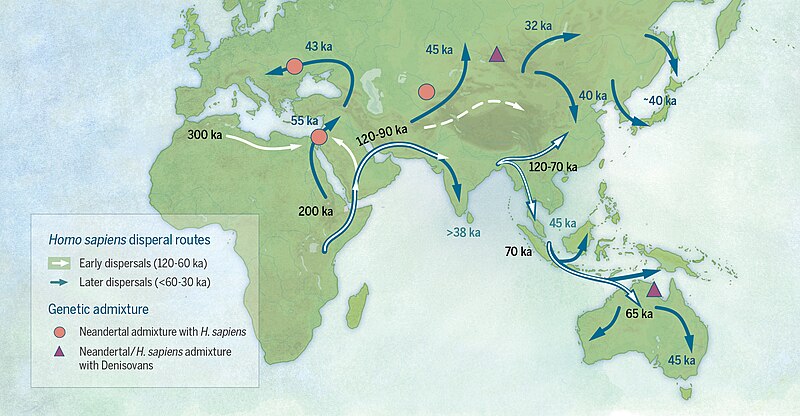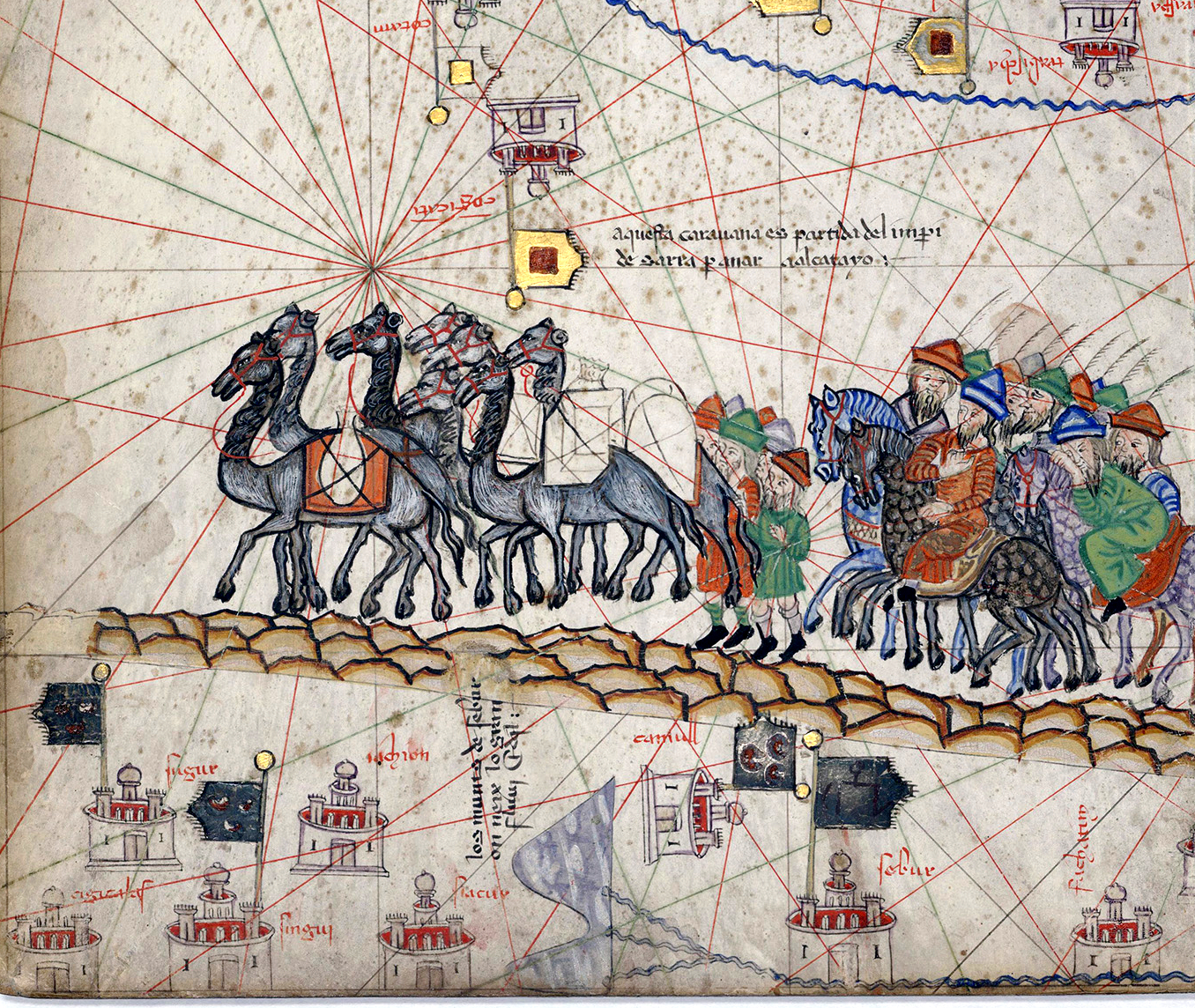
Now that we know what our people look like, let’s explore cities in a fantasy society. Not literally explore them, just explore the topic. We didn’t necessarily need to know what the people look like in order to know where they live. This topic could have come first, but it is intrinsically bound with other topics we will explore in the next few articles.
Why and Where before the How
We’ll deal with the How, the actual layout of the city, in the next article. It is the level of detail that your characters interact with and is the bare minimum your will need for writing a story in an urban setting. Before we get to that, let’s look at the Why. Why do people settle in villages, towns, and cities to begin with? It’s possible the people in your world don’t live in cities at all.
On Earth, humans evolved on the savannahs of Africa and spread throughout the world during the Paleolithic period (old stone age). For 200,000 years, Homo sapiens lived off the land, hunting animals and gathering plants for food and textiles. While humans built shelters out of wood, clay, straw, they were mostly campsites for nomadic tribes.

It is possible to write a fantasy story in a Paleolithic setting. The Clan of the Cave Bear series by Jean M. Auel is a great example.
Earliest Settlements
It was only in the Neolithic period (new stone age) that humans built permanent settlements. This coincided with the advent of agriculture about 11 thousand years ago with the climate warming at the end of the ice age. Farming began when hunting and gathering wild grains was not enough to support populations. The population grew in good times. When drought constricted food supply, people turned to farming to survive.
Farming required the farmer to stay in one area to tend to the crops. If the family moved elsewhere, another family might move in and harvest the crops the first family worked so hard to grow.
In this period, lasting for thousands of years, people lived in villages of about 50-100 people. Villages would be governed by the elders of the clans. The villagers were not subjects of a king, nor were they citizens of a republic, though a village might have headman as a leader.
The practice of farming spread as people migrated, taking agricultural techniques with them. Neolithic agricultural techniques and societies persisted among humans clear through the industrial revolution. Except for the introduction of iron tools and the rule of kings, the vast majority of peasants from ancient to medieval times lived an essentially neolithic lifestyle.

Villages to Towns, City-States, and Empires
Villages grew larger in the bronze age. It was in this period that political power grew stronger, more organized, and more centralized. Hereditary chieftains or kings supported by a class of priests arose around this time. The king often acted as the chief priest or claimed the mandate of the gods. This was about the time of the Uruk period in Mesopotamia and the Zhou period in China.
Centralized power coincided with the development of organized irrigation. Agricultural technology allowed the accumulation of surplus food, which allowed a division of labor. This coincided with the advent of writing, which was first used to record accounts (Egypt and Sumeria) and as oracles (China).
Cities in Fantasy
The first question one needs to answer in planning cities in a fantasy society is whether there are cities at all. Humans developed agriculture in response to environmental stress. That led to writing and cities. Did the humans, humanoids, or non-human species of your world face the same pressures? In other words, Does your fantasy society need cities and towns at all?
Humans lived in nomadic tribes for hundreds of thousands of years in the Paleolithic era. One could imagine the Silvans of Pancirclea living in simple shelters in the forests, moving from place to place following the seasons or pursuing food sources. They would be uncivilized in the sense that they don’t live in cities, but that does not mean they wouldn’t have a complex culture. Perhaps they would not develop writing or smelting, but they might borrow such things from nearby civilizations.

Development of Cities and Civilization in Fantasy
In your fantasy society, if you want to look at the history of cities and civilization on your continent, you really only need to go as far back as a Bronze Age. This is when cities on earth grew and developed the attributes of writing, smelting, and complex government. Also, this is when the first empires were founded.
On my map of Pancirclea, I started with an area where farming might have begun. It is a hilly area where a warming climate changed the biome from a fertile one able to support a large population to a less fertile one unable to support the same population. In this case, people developed farming to increase their food supply.
Over the course of hundreds of years, farming techniques spread, including irrigation in the river valleys, which involved more complex social organization and the foundation of what we now think of as cities. This is the core of civilization on Pancirclea.
Over time, they spread to other areas suitable for farming, sending colonies to relieve population pressure at home. These colonies encroached on the homelands of the Silvan people and Hillfolk, causing conflict and possible war. One can imagine the city people invading the Hillfolk lands to seize mines for metal ores. One can also imagine the Silvans attacking settlers who attempt to clear forests for more farmland.

Placement and Growth of Cities
We have answered the Why. Let’s look at the Where. Where are cities placed? Part of the answer depends on why the city is founded and the social conditions that it is founded under. Did it grow from a neolithic village or was it founded as a colony from another city? Was it a peaceful era with few external threats or were the founders worried about bandits, marauders, foreign armies, or other enemies?
Defense and Trade
The two main factors determining where cities grow are defense and trade. Cities are by their nature centers of trade, religion, and politics. Originally, they grew from towns as population increased. Technological innovations such as literacy, bronze smelting, and legal codes allowed economic diversity. Scholars have attempted to define a the origin of cities using characteristics similar to these.
On the other hand, many cities were founded intentionally, especially in later empires such as the Roman. Major cities such as Milan, Florence, Cologne (Colonia in Latin), and London were all Roman colonies. Many colonies were established for defensive purposes outside Roman territory.

Many cities grew around military forts or castles, often forts of conquered people. For example, Colchester, England, Paris, France, and Cologne, Germany. Cities also grew around hill forts such as Prague, Czechia, Delhi, India, and the Kremlin, Moscow.
Trade Drives Growth
Trade routes allowed cities to grow beyond their original defensive purposes. Often, merchants settled near forts to take advantage of the protection of the military based there. This became the core of a new city. Trade was always the driver for the growth of cities. Cities along trade routes grew richer and larger. It begs the chicken and egg question: did the first cities grow along trade routes or did the first trade routes grow between larger towns? Whichever comes first, settlements grow where trade routes nourishes them.

The two factors of defense and trade ebbed and flowed in importance depending on the conditions of the time. In warlike eras, defense became more important. Cities on hills or islands had an advantage during times of unrest. Cities better situated along rivers or across easily traversable terrain had an advantage during peaceful times when trade flourished. Those that had both, such as Paris or Venice, flourished under both conditions.
Everybody Loves a Water Feature
Another key need for the growth of cities is water. A large population needs fresh water to survive. For this reason, most large cities grow near plentiful water supplies, usually rivers. The first cities were along the Nile, Tigris, Euphrates, Indus, and Yellow Rivers. Sometimes, the cities built canals or aqueducts to bring water to them. Roman Aqueducts are still considered an engineering marvel. China’s second great engineering marvel is the Grand Canal, linking Beijing in the north to Hangzhou in the south.
Rivers and canals also allow increased mobility with boats and barges, increasing the ability to trade with other cities on the river.

Common sites for Cities
Some of the most common sites for major cities are:
On islands in rivers. E.g. Paris, Cologne, Berlin, Syracuse, Sicily

At fords across rivers. E.g. Paris

At river crossings suitable for bridges. E.g. London.

At the confluence of rivers. E.g. Lyons, France, Erlitou, China.

Hmmm. Is there a theme here?
Hill Towns
Not all cities are placed on rivers. As I said earlier, some were created around hill forts for defensive purposes. The hill towns of Tuscany or ancient Palestine were placed at the top of hills, but each of them needed an abundant source of water, usually from wells. These cities usually succeeded in times of social unrest or particularly warlike periods due to their defensive advantages.

Cities in a Fantasy Society
Again, placement of cities in a fantasy society goes back to the map. Find the area where civilization first developed. Cities in those areas will grow organically based on the factors of defense, trade, and access to water.
Next, look to where people would intentionally found cities as they spread from their home civilizations. What would be the best sites for colonies?
At this point, you might not have enough detail to determine where islands or fords in rivers might be. In Pancirclea, I placed cities where it looked like a good place for a kingdom or empire to grow, then drew in additional rivers and streams to provide water for the city. As the worldbuilder, you have the freedom to add detail as you focus in. When you do, pay attention to the guidelines set up in earlier articles, especially on landforms.
One hint for islands and fords is that water is generally shallower and islands form where rivers grow wide in low flat areas. Rivers are also shallower above river confluences.
One hint for islands and fords is that water is generally shallower and islands form where rivers grow wide in low flat areas. Rivers are also shallower above river confluences.

Rather than naming my cities now, I gave them letter designations. Names are a function of language, so I’ll give them names that conform to the language of the inhabitants when I discuss that later. I’m pretty excited to get to that topic. I love conlangs (constructed languages).
Now we know where the cities of our fantasy world are and where the trade routes that link them lie. In the next topic, I’ll talk about the How of cities, focusing in on individual cities and their layout. What are the major features? How are the streets laid out?
5 Comments